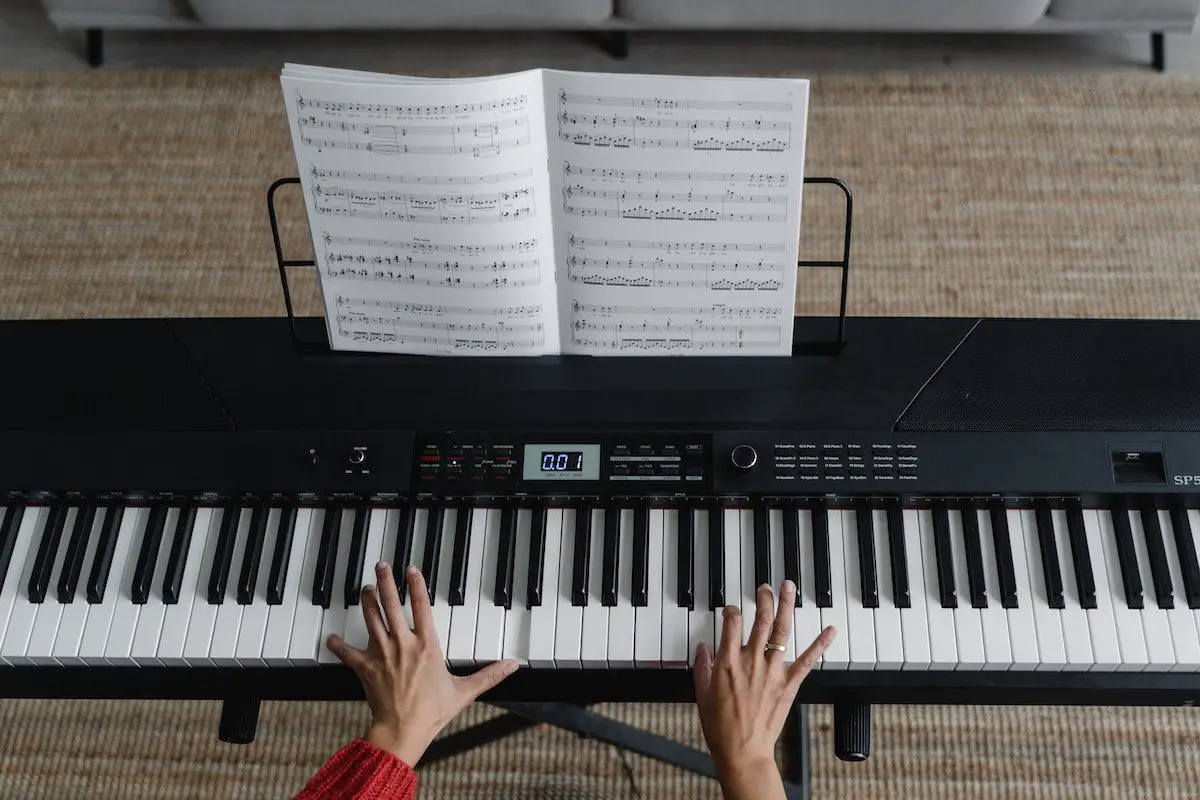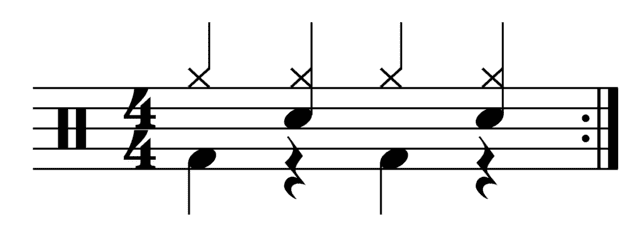Picture this – you’re at a concert, the rhythm is pulsating, and without even thinking about it, your body begins to sway to the beat. One-two-three-four, one-two-three-four – there’s a distinct pattern that’s almost hypnotic, ingraining itself into your subconscious. This is no accident; you’re actually experiencing the quintessential beat pattern in Western music, known as the quadruple meter.
What does quadruple meter mean? Quadruple meter refers to a musical measure that has four beats, with the first beat typically being the strongest or most emphasized. In such a meter, you’d count the beats as “1, 2, 3, 4” for each measure. Popular music often uses quadruple meter, making it one of the most common meters in Western music.
What is a quadruple meter?
A quadruple meter refers to a rhythmic pattern with four beats to a measure. In this meter, the first beat is typically the strongest, followed by a weaker second beat, a slightly emphasized third beat, and the weakest fourth beat. It’s often notated in time signatures like 4/4, where the top number indicates there are four beats in each measure. The rhythm of a quadruple meter can be counted as “1, 2, 3, 4” for each measure.

AKAI Professional MPK Mini MK3

AKAI Professional MPK Mini MK3
What are some examples of songs in a quadruple meter?
Several songs across various genres are written in quadruple meter, which is often notated as 4/4. Here are some examples:
- “Yesterday” by The Beatles
- “Hallelujah” by Leonard Cohen
- “Let It Be” by The Beatles
- “Imagine” by John Lennon
- “Someone Like You” by Adele
- “Clocks” by Coldplay
- “Hotel California” by The Eagles
- “Bohemian Rhapsody” by Queen
What is simple quadruple and simple duple time?
Simple time is a time signature with a top number of 2, 3, or 4. The bottom number of the time signature shows the type of note equating to one basic beat.

- 16 = a sixteenth note
- 8 = an eighth note
- 4 = a quarter note
- 2 = a half note
Simple duple time is a time signature with a top number of 2. We’re talking 2 basic beats per measure. Roll over to simple quadruple time and you’ve got a time signature with a top number of 4, meaning there are 4 basic beats per measure.
How can you tell if it’s a simple quadruple or duple?
Check this out, there’s an exercise to help you nail this concept. Imagine a tune. Got it? Now, scoop each Basic Beat in that rhythm or melody, add the Basic Beat below each scoop, and get your pulse working below each Basic Beat. If you’re thinking this might feel crazy, you’re right. It’s all about feeling the music and moving with it. But remember, we’re all learners here. I still get tripped up sometimes.
And here’s the sneaky fact – there’s sometimes more than one correct answer! Since there’s not always a ton of “musical information”, you can argue it for either Simple Quadruple or Duple. Crazy, right? We’re lucky enough to have some tips to help you out here:
- Knockin’ on the Beams: Look at how the eighth notes are beamed. If they’re beamed into groups of 2, you could be dealing with Simple Quadruple. If they’re beamed into groups of 4, well, you’re looking at Simple Duple.
- Irregular Groupings: Sometimes how the Composer groups notes can guide us towards a Simple Quadruple or Duple.
- Feeling the Pulse: Remember that “Clap, Tap, and Rap” game? Clap the rhythm, tap the Basic Beat with their foot, and feel the pulse. It’s all about getting into the vibe of the music.
You can “prove” the time signature by being able to comfortably and easily “Clap, Tap, and Rap” it, and that’s like the music production equivalent of saying “I’m Batman” in the middle of the Gotham streets. It’s strong, confident, and cool.
How does simple quadruple or duple impact the way we feel rhythm?
You might wonder whether Simple Quadruple or Duple Time has any impact on the way we feel rhythm. Well, you’re in for a treat. The way Simple Quadruple or Duple Time works is like the heartbeat of the music. It’s the steady, consistent pulse that keeps the rhythm flowing, similar to an engine driving a beat-up van on a cross-country tour. This palpable pulse you can feel in your bones, that’s the Basic Beats per measure in action.
What’s the importance of basic beats and pulses?
Why should we be concerned with scooping basic beats and adding pulses? Well, because they’re what gives the rhythm its groove! The basic beats and pulses act as the foundation of the rhythm. Like the main nuts and bolts in your favorite musical device, they keep the music’s structure, giving you the freedom to tap your foot, snap your fingers, or head-bang to your heart’s content.
How does this all connect to home recording studios or music production?
Let’s think about this in terms of home recording studios and music production. The rhythm is CRUCIAL in producing a good track, whether it’s a classic rock anthem or a head-bopping hip-hop beat. A rockin’ rhythm could mean the difference between a sick beat and a song that gets left on the cutting room floor.
So, after all, Simple Quadruple or Duple time do more than just contribute to the rhythm; they make the music what it is. Alright, that’s enough chit-chat. Time to play some tunes and feel the rhythm.
If you want even more great tips and information, check out the video.
Frequently Asked Questions (FAQ)
Let’s explore a few more curiosities your musical mind might be conjuring regarding simple quadruple or simple duple time. No worries, i’ve got the answers to keep you strumming along.
Can simple quadruple or simple duple time vary within the same song?
Most certainly! Just as you would change your vocal pitch or the keys in a song, you can switch between Simple Quadruple and Simple Duple Time. This can add some serious spice to your tunes and keep the listeners on their toes.
How can I practice distinguishing between simple quadruple and simple duple time?
Listening to a good variety of music genres can help a lot. Pay attention to the rhythm and how the beats pulse. Try tapping along, and you’ll start getting the hang of it. There are also many music theory apps that can help you hone this skill.
Are there specific genres of music that typically use simple quadruple or simple duple time?
While Simple Quadruple, or common time, is prevalent across all genres, some do lean more towards one or the other. Pop and rock music often use Simple Quadruple Time, while folk and reggae music generally lean towards Simple Duple Time.
Conclusion
And there we have it, a complete run-through of simple quadruple and simple duple time. Did I cover everything you wanted to know? Send your thoughts my way down in the comments section – I read and reply to every comment. If you found this blog post helpful, pass it on to a fellow music enthusiast and check out my full blog for more tips on nailing down the rhythm and time signatures. Until next time, keep your beats groovy and your rhythm smooth!
Key Takeaways
This article covered the ins and outs of Simple Quadruple and Simple Duple Time. Here are some key takeaways:
- Simple Quadruple and Simple Duple Time revolve around the Basic Beats per measure.
- Simple Duple Time contains two Basic Beats per measure, while Simple Quadruple Time has four.
- Identifying the time signature can be done through beaming, irregular groupings, and feeling the pulse.
- The pulse and Basic Beats form the foundation of rhythm, enhancing the grooviness in music production.
- Music production benefits from the implementation of Simple Quadruple and Simple Duple Time in rhythm creation.















